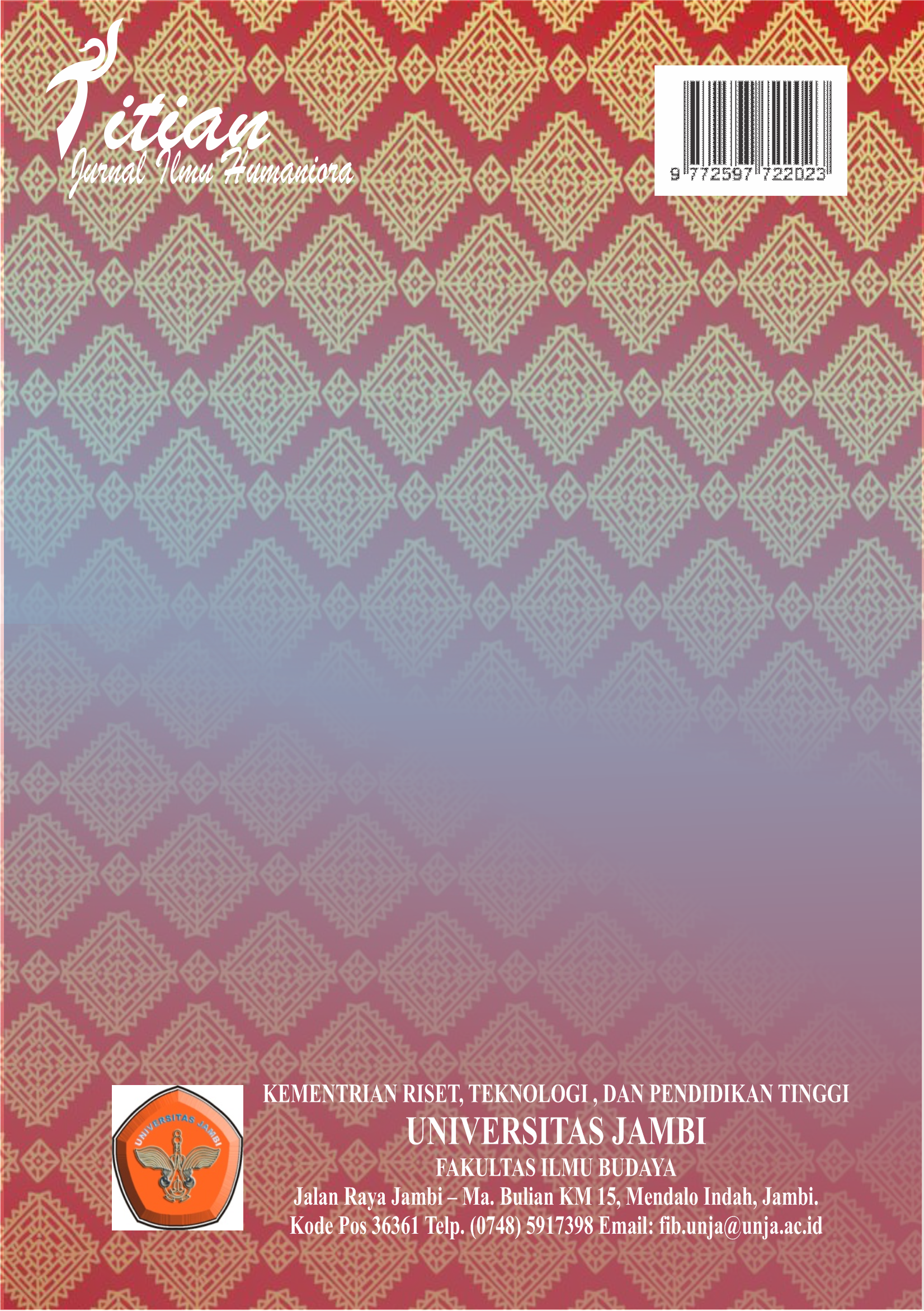Sejarah Tradisi Budaya Poligami di Dunia Arab Pra Islam (Perspektif Tradisi Coomans Mikhail)
DOI:
https://doi.org/10.22437/titian.v7i1.23588Keywords:
poligami, tradisi, Arab Pra-Islam, budaya, sejarahAbstract
Penelitian ini terfokus pada pengungkapan dan penyingkapan tradisi poligami yang dibudayakan pada masyarakat Arab dengan tujuan yang bermacam-macam, sehingga perlu adanya kacamata untuk melihat peristiwa tersebut. Adapun cara melihat fenomena tersebut, penelitian ini menggunakan teori histori Ibnu Khaldun dan perspektif yang dikemukakan oleh Coomans Mikhail. Adapun metode penelitian yang digunakan adalah kualitatif deskriptif bercorak kajian pustaka. Hasil dari penelitian ini adanya praktek poligami yang sudah lazim pada bangsa Arab kuno, dalam sejarah dikatakan bahwa Arab kuno telah mengenalnya dengan contoh nabi-nabi terdahulu memiliki banyak selir yang dijadikan istri seperti nabi Sulaiman. Hal tersebut mempengaruhi budaya pada Arab jahiliyyah atau pra-Islam dengan tujuan-tujuan bermacam, yaitu memperbanyak keturunan sebagai kekuatan dan kemulian, menjalin politik antar suku, dan asumsi bahwa wanita adalah benda warisan serta budak semata. Kemudian implikasi poligami untuk masa kini berupa pertanyaan tentang sisi Islami dan Jahili, sehingga para pembaca dapat menyikapi praktek poligami ini secara religiusitas dan juga rasionalitas guna meminimalisir pandangan negatif tentang praktek poligami.
Abstract
This research focuses on disclosing and explaning the polygamy tradition that is cultivated in Arab society with various purposes, so that there is a need for glasses to see this event. As for how to look at this phenomenon, this study uses the historical theory of Ibn Khaldun and the tradition perspective put forward by Coomans Mikhail. The research method used is descriptive qualitative with literature review. The result of this study is that the practice of polygamy in the ancient Arabs has begun, in history it is said that the ancient Arabs had known it with the example of previous prophets having many concubines who were made wives like the prophet Sulaiman. This influenced the culture of the Jahiliyyah or pre-Islamic Arabs with various goals, namely multiplying offspring as strength and glory, establishing inter-ethnic politics, and the assumption that women were mere inheritance and slaves. Then the implications of polygamy for the present are in the form of questions about the Islamic and Jahili sides, so that readers can address the practice of polygamy religiously and also logically in order to minimize negative views about the practice of polygamy.
Downloads
References
A. Kumedi Ja’far, Rudi Santoso, A. H. (2020). A Sociohistorical Study of Polygamy and Justice. 492(Education and Humanities), 338–342.
Al-Aqad, A. M. (2013). As-Saqafah Al-Arabiyah (Ihab Salim (ed.)). Hindawi.
Al-Ithar, A. N. T. (2009). تعدد الزوجات من النواØÙŠ الدينية والإجتماعية والقانونية (p. 360).
Alfani, M. F. (2023). The Meaning of Rahmatan Lil Alamin in the Contemporary Tafseer of Muhammad Quraish Shihab. International Journal of Social Science and Religion (IJSSR), 61–76. https://doi.org/10.53639/ijssr.v4i1.132
Ali, M. M. (2022). تعدد الزوجات بين التراث والمعاصرة (p. 22).
Anam, H. F. (2020). Poligami Dalam Hermeneutika Feminis Amina Wadud Haikal. 19(1), 43–54.
Atabik, A. (2014). Teori Kebenaran Perspektif Filsafat Ilmu. Fikrah, Vol. 2, No. 1, Juni 2014, 2(1), 253–271.
Coomans, M. (1987). Manusia Daya: Dahulu, Sekarang, Masa Depan. PT Gramedia.
Fauziyah, S. (2012). Poligami nabi Muhammad dalam Perspektif Sejarah. In Tsaqofah (Vol. 10, Issue 01, pp. 34–49).
Glassie, H. (1995). Tradition. American Folklore Society, 108(430), 395–412.
Hakim, A. (2022). Poligami di dunia islam. July 2021. https://doi.org/10.21274/ahkam.2021.9.1.105-128
Hitti, P. K. (2002). History of Arabs (Kesepuluh). Macmilan, Plagrave.
Ichsan, M. (2018). Poligami dalam Perspektif Hukum Islam (Kajian Tafsir Muqaranah). JURIS (Jurnal Ilmiah Syariah), 17(2), 151. https://doi.org/10.31958/juris.v17i2.1196
Jasim, H. I. (2008). الزواج وأثره على Øياة العرب قبل الإسلام. المجلد 4, 13(الزواج), 168.
Khoiriah, R. L. (2018). Poligami Nabi Muhammad Menjadi Alasan Legitimasi Bagi Umatnya serta Tanggapan Kaum Orientalis. Jurnal Living Hadis, 3(1), 1–21. https://doi.org/10.14421/livinghadis.2017.1374
Koentjaraningrat. (2015). Pengantar Ilmu Antropologi. Rineka Cipta.
Mustofa, M. A. (2017). Poligami Dalam Hukum Agama Dan Negara. AL-IMARAH: Jurnal Pemerintahan Dan Politik Islam, 2(01), 47–58. https://ejournal.iainbengkulu.ac.id/index.php/alimarah/article/view/1029
Nadia, S. (2021). Menelaah Hukum Pernikahan Monogami dan Poligami Perspektif Hadis. 2(2), 123–140.
Rashad, H., Osman, M., & Roudi-fahimi, F. (2004). Marriage In The Arab World.
Rohman, F., & Kusaeri, K. (2021). Penilaian Kemampuan Berpikir Kritis Dalam Pembelajaran Fikih Dengan Watson-Glaser Critical Thinking Appraisal (WGCTA). EDUKASI: Jurnal Penelitian Pendidikan Agama Dan Keagamaan, 19(3), 333–345. https://doi.org/10.32729/edukasi.v19i3.874
Sipayung, T. (2012). Akibat Buruk Perceraian Suami-Istri Terhadap Perkembangan Mental Anak. 116–122.
Srisusanti, S., & Zulkaida, A. (2013). Studi Deskriptif Mengenai Faktor-Faktor Yang Mempengaruhi Kepuasan Perkawinan pada Istri. UG Jurnal, 7(6), 8–12.
Sujati, B. (2018). Konsepsi Pemikiran Filsafat Sejarah Dan Sejarah Menurut Ibnu Khaldun. 6(2), 127–148.
Sunaryo, A. (2010). Poligami di Indonesia (sebuah analisis normatif-sosiologis). Yinyang: Jurnal Studi Islam Gender Dan Anak, 5(1), 143–167. http://ejournal.iainpurwokerto.ac.id/index.php/yinyang/article/view/265
Downloads
Published
How to Cite
Issue
Section
License
Copyright (c) 2023 Muhammad Jafar Shiddiq Jafar

This work is licensed under a Creative Commons Attribution-ShareAlike 4.0 International License.































